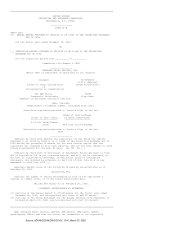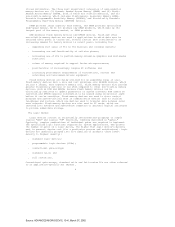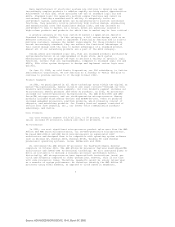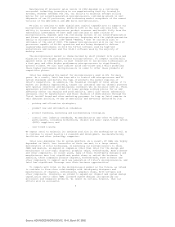AMD 2001 Annual Report Download - page 13
Download and view the complete annual report
Please find page 13 of the 2001 AMD annual report below. You can navigate through the pages in the report by either clicking on the pages listed below, or by using the keyword search tool below to find specific information within the annual report. In order to remain competitive, we must continue to make substantial
investments in the improvement of our process technologies. In particular, we
have made and continue to make significant research and development investments
in the technologies and equipment used to fabricate our microprocessor products
and our Flash memory devices. Portions of these investments might not be fully
recovered if we fail to continue to gain market acceptance or if the market for
our microprocessor or Flash memory products should significantly deteriorate.
In addition, if we are unable to remain competitive with respect to process
technology, we will be materially and adversely affected.
Competition
The IC industry is intensely competitive. Products compete on performance,
quality, reliability, price, adherence to industry standards, software and
hardware compatibility, marketing and distribution capability, brand
recognition and availability. After a product is introduced, costs and average
selling prices normally decrease over time as production efficiency improves,
competitors enter the market and successive generations of products are
developed and introduced for sale. Technological advances in the industry
result in frequent product introductions, regular price reductions, short
product life cycles and increased product capabilities that may result in
significant performance improvements.
In each area of the digital IC market in which we participate, we face
competition from different companies. With respect to microprocessors, Intel
holds a dominant market position. With respect to Flash memory products, our
principal competitors are Intel, STMicroelectronics N.V., Sharp Electronics
Corporation, Atmel Corporation and Fujitsu, our joint venture partner in FASL.
Manufacturing Facilities
Our current IC manufacturing facilities are described in the chart set forth
below:
Wafer Approximate
Size Production Clean Room
(Diameter Technology (Square
Facility Location in Inches) (in Microns) Footage)
----------------- ---------- ------------ -----------
Austin, Texas
Fab 25.................................. 8 0.18 120,000
Fabs 14 and 15.......................... 6 0.5 42,000
Aizu-Wakamatsu, Japan
FASL JV1/(1)/........................... 8 0.35 70,000
FASL JV2/(1)/........................... 8 0.25 & 0.35 91,000
FASL JV3/(1)/........................... 8 0.17 118,000
Dresden, Germany
Fab 30.................................. 8 0.18 115,100
--------
/(1)/ We own 49.992 percent of FASL. Fujitsu owns 50.008 percent of FASL.
In connection with a restructuring plan announced in September 2001, AMD
will close Fabs 14 and 15 at the end of the second quarter of 2002.
The FASL JV3 building and clean room were completed and released to
production with volume revenue shipments beginning in the fourth quarter of
2001.
We also have foundry arrangements for the production of our products by
third parties.
Research and development are conducted at our Submicron Development Center,
a 42,000 square foot facility located in Sunnyvale, California, Fab 25 and
Dresden Fab 30.
9
Source: ADVANCED MICRO DEVIC, 10-K, March 07, 2002
























